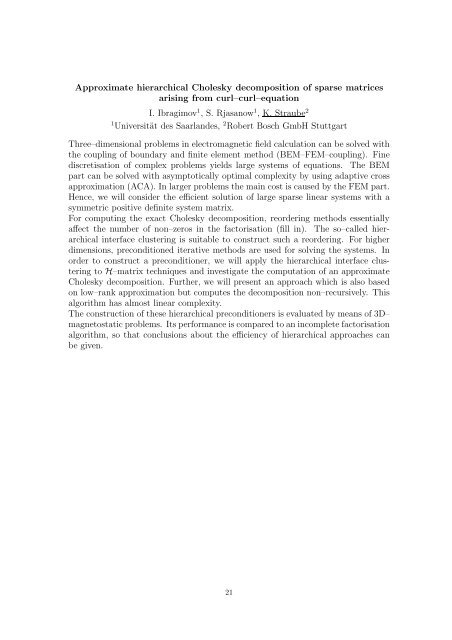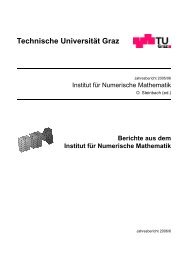Technische Universit¨at Graz - Institut für Numerische Mathematik
Technische Universit¨at Graz - Institut für Numerische Mathematik
Technische Universit¨at Graz - Institut für Numerische Mathematik
Create successful ePaper yourself
Turn your PDF publications into a flip-book with our unique Google optimized e-Paper software.
Approximate hierarchical Cholesky decomposition of sparse matrices<br />
arising from curl–curl–equation<br />
I. Ibragimov 1 , S. Rjasanow 1 , K. Straube 2<br />
1 Universität des Saarlandes, 2 Robert Bosch GmbH Stuttgart<br />
Three–dimensional problems in electromagnetic field calculation can be solved with<br />
the coupling of boundary and finite element method (BEM–FEM–coupling). Fine<br />
discretisation of complex problems yields large systems of equations. The BEM<br />
part can be solved with asymptotically optimal complexity by using adaptive cross<br />
approximation (ACA). In larger problems the main cost is caused by the FEM part.<br />
Hence, we will consider the efficient solution of large sparse linear systems with a<br />
symmetric positive definite system matrix.<br />
For computing the exact Cholesky decomposition, reordering methods essentially<br />
affect the number of non–zeros in the factorisation (fill in). The so–called hierarchical<br />
interface clustering is suitable to construct such a reordering. For higher<br />
dimensions, preconditioned iterative methods are used for solving the systems. In<br />
order to construct a preconditioner, we will apply the hierarchical interface clustering<br />
to H–matrix techniques and investigate the computation of an approximate<br />
Cholesky decomposition. Further, we will present an approach which is also based<br />
on low–rank approximation but computes the decomposition non–recursively. This<br />
algorithm has almost linear complexity.<br />
The construction of these hierarchical preconditioners is evaluated by means of 3D–<br />
magnetostatic problems. Its performance is compared to an incomplete factorisation<br />
algorithm, so that conclusions about the efficiency of hierarchical approaches can<br />
be given.<br />
21




